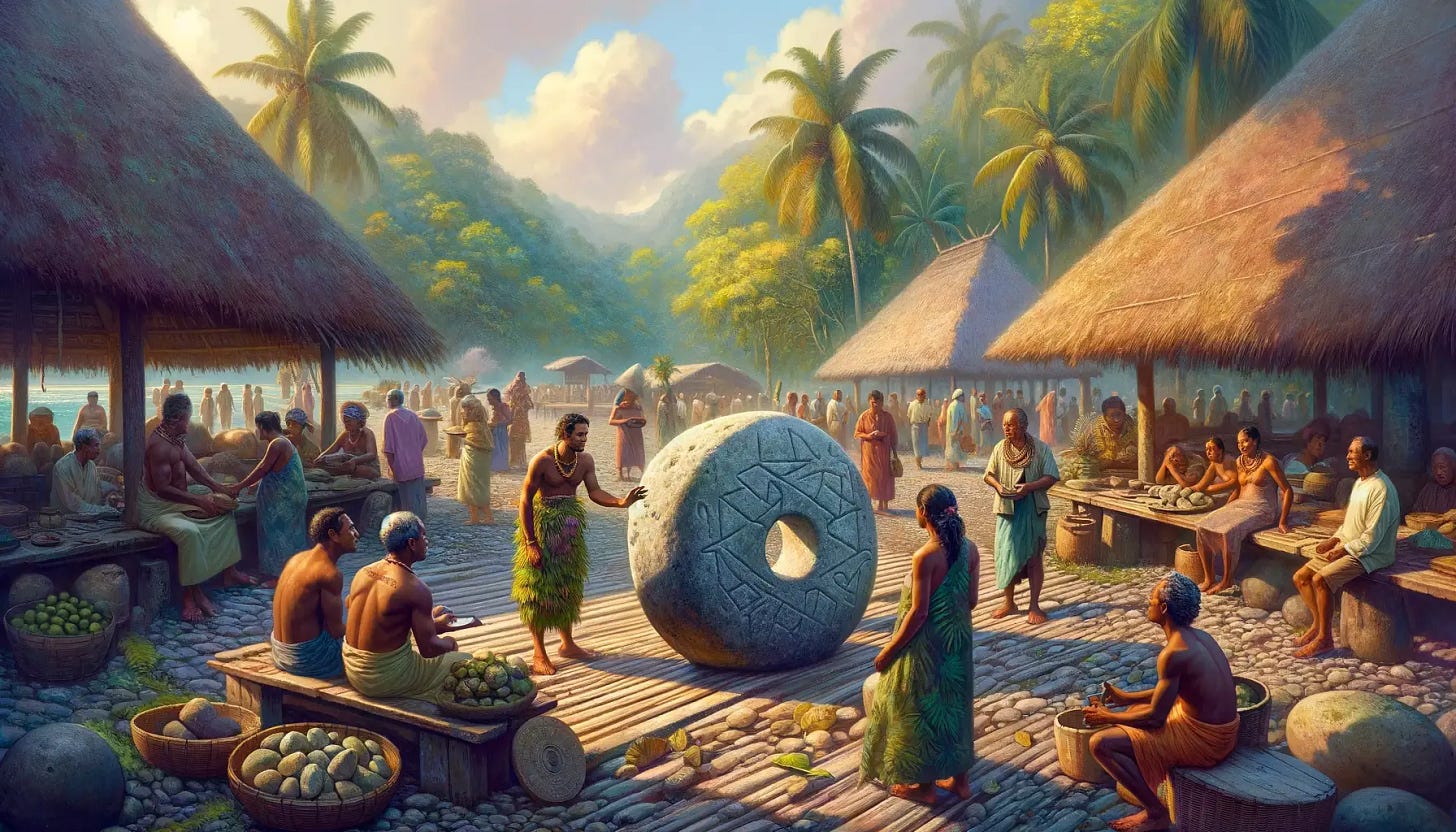Rai Stones - Decentralized Money from 500 A.D.
The Rai Stones from Yap Island were the first to decentralize money and the ownership of capital.
When we look at the blockchain and coin ownership on the chain, it might look like a brand-new thing humans have never tried before. But we can look at history for some inspiration.
Something like blockchain has been tried and used before successfully. Around 500 AD. These were the Rai Stones from Yap Island. The Rai stones on Yap Island are large, circular stone disks, with a hole in the middle, that the Yapese people used as a form of money. These stones varied in size, with some reaching diameters of up to 12 feet (3.6 meters).
They were made from limestone and were quarried on several islands, most notably on Palau, which lies about 400 kilometers away from Yap. Transporting these stones back to Yap was a dangerous and labor-intensive endeavor, which added to their value. This is similar to Bitcoin mining because to mine Bitcoins you have to spend real-world resources such as electricity to mine it.
The Rai stones represent one of the earliest known forms of decentralized money for several reasons:
Community Consensus
The value of a Rai stone was not determined by a central authority but was based on its size, history, and the difficulty of bringing it to Yap. This valuation was agreed upon by the community, making it a decentralized system of value. If someone sells their house for a Rai stone, the ownership of the stone will be transferred to the seller which acts as a store of value to buy something else (maybe a farm) in the future.
Oral Ledger
The stones were placed in the village at several locations and the stones never moved, just like that coins on the blockchain never move. Only the “private keys” are transferred from one person to the other.
Transactions were recorded in the community's collective memory, serving as an oral ledger. Everyone knew who the rightful owner of each stone was, even if the stone itself remained in the same place. The richest person on the island might own many large Rai stones and the entire community knew who owns these stones.
Trust and Verification
The system relied on mutual trust and the verification of transactions through communal acknowledgment. This aspect is similar to the trustless verification process seen in Bitcoin, although it was facilitated through social consensus rather than cryptographic algorithms. This was possible because it was an island with everyone knowing everyone. This couldn't have scaled to the whole world unless we have something in the digital realm, that is Bitcoin.
The Rai stones are considered the first type of decentralized money because they exhibit key characteristics of decentralization: lack of a central controlling authority, reliance on a shared consensus to validate transactions, and an oral ledger system for tracking ownership and transfers.
This decentralized system of value and trust enabled the Yapese to facilitate large transactions and maintain social cohesion without the need for a physical exchange of currency or a centralized banking system. Most importantly, the total supply of these stones was limited making existing stones appreciate as the island improved in productivity.
Eventually, the Rai stones failed as a form of currency. The Rai stones of Yap Island did not "fail" in the traditional sense of a currency becoming worthless or abandoned overnight.
Instead, the system evolved and became less central to the economy of Yap due to several factors, including external influences and the introduction of more conventional forms of currency. Here are some of the reasons that contributed to the decrease in the reliance on Rai stones as a form of currency:
External Contact and Influence
The arrival of Europeans and other outsiders introduced new goods, ideas, and forms of currency to the Yapese people. This external contact gradually shifted the economic practices on the island, as the Rai stones were not easily divisible or practical for use in transactions involving smaller, more commonly traded goods or services introduced by foreigners. This is not a problem with Bitcoin because each Bitcoin has 100,000,000 Satoshis. When Bitcoin reaches $1M each Satoshis will be 1 cent (1/100th of a dollar) in value.
Taxation with Modern Currency
With the colonization and administration by foreign powers, such as the Germans and the Japanese, modern currency systems were introduced to Yap. These currencies were more practical for daily transactions and were enforced by the colonial administrations for tax and trade purposes, further diminishing the role of Rai stones in the local economy.
Preservation of Cultural Heritage
While the use of Rai stones as an active currency diminished, they remain a significant part of Yap's cultural heritage. The stones are still recognized for their historical and cultural value, and ownership transfers, though rare, are still recognized within the community for traditional purposes.
Even if Bitcoin doesn't become the world standard for measuring value, it can never go to zero because people will want to hold it for the long term and it will have value as long as other people want to hold it. The limited amount of Bitcoins in circulation makes it more valuable over time.
The total Bitcoins available for sale in exchanges across the world has dropped from 3.2 million in 2020 to around 2 million in early 2024. This is one of the most important metrics in Bitcoin today - the total coins available for sale. If it is dropped, then the price has to go up accordingly.
You can learn more about Rai Stones from YouTube and Google.


